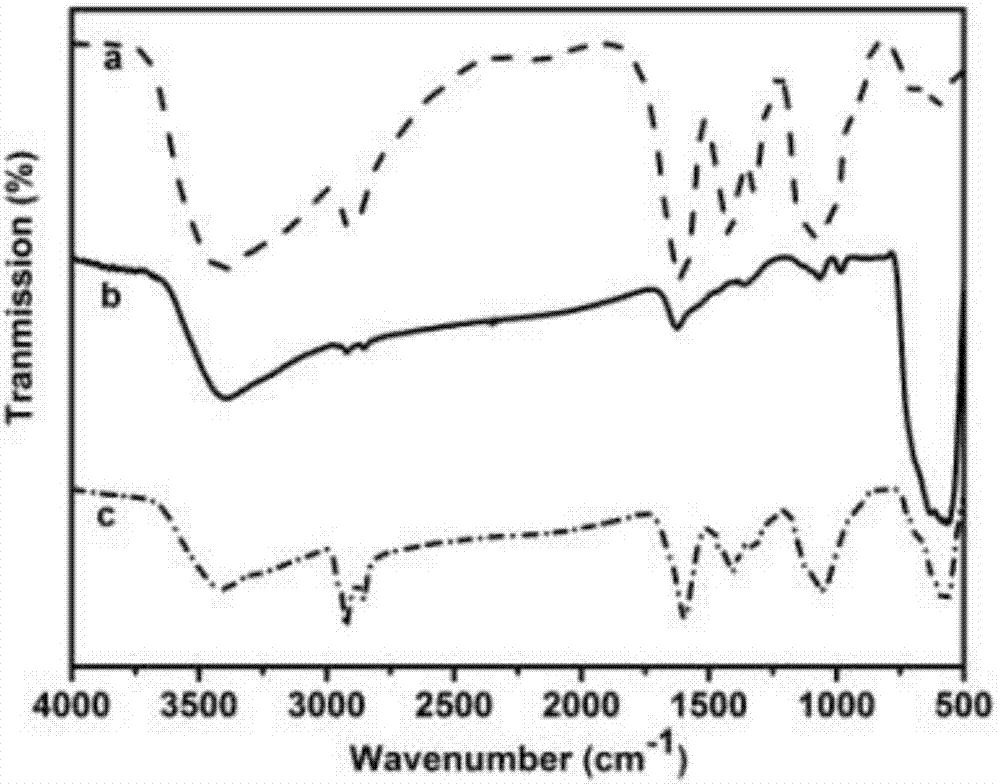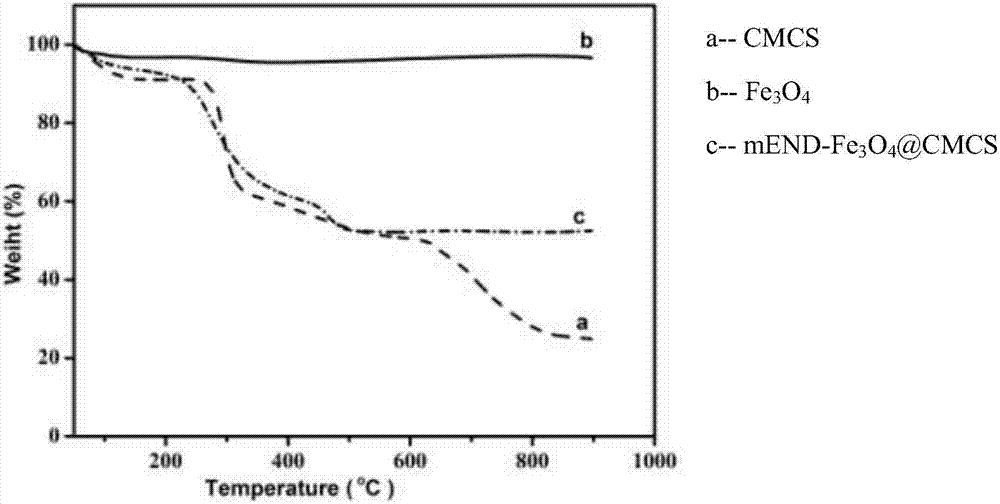Method for preparing specific magnetic Endoglin aptamer imaging probe system
An imaging probe and aptamer technology, applied in the field of biomedical engineering, can solve the problems of time-consuming technical requirements, complicated operation, and side effects, and achieve the effects of high relaxation rate, simple preparation process and low toxicity
- Summary
- Abstract
- Description
- Claims
- Application Information
AI Technical Summary
Problems solved by technology
Method used
Image
Examples
Embodiment 1
[0030] Preparation of magnetic Fe by hydrothermal method 3 o 4 Nanoparticles:
[0031] Weigh 2.502 g (0.009 mol) of ferrous sulfate heptahydrate, dissolve in 30 mL of ddH 2 O, and add 10 mL of PEG-2000 aqueous solution with a concentration of 50 g / L, stir and mix well, and add 30 mL of dilute ammonia water drop by drop, continue to stir rapidly, and add 270 μL H2 o 2 solution, until the solution turns black, continue to stir for 20 min; transfer the solution to a high-pressure reactor, react at a constant temperature of 160 °C for 6 h, magnetically separate and wash 3 times, and dry at 70 °C to obtain the magnetic Fe 3 o 4 Nanoparticles.
Embodiment 2
[0033] Magnetic Chitosan Nanoparticle Fe 3 o 4 Preparation of @CMCS:
[0034] Weigh carboxymethyl chitosan CMCS 0.4 g in 20 mL ddH 2 In O, filter after stirring and dissolving completely, and the filtrate is set aside; add 0.4 g of Fe prepared in the filtrate 3 o 4 Magnetic nanoparticles, sonicated for 5 min to obtain evenly dispersed Fe 3 o 4 Magnetic nanoparticle dispersion; add 58.2 mL of liquid paraffin oil and 1.8 mL of span-80 to a 250 mL three-necked bottle; then add the evenly dispersed Fe 3 o 4 Magnetic nanoparticle dispersion (aqueous phase), the mixed solution was ultrasonicated for 30 min to disperse evenly, fully stirred for 2 h; add 2 mL of 25% glutaraldehyde solution, and continue stirring for 1.5 h; after the reaction was complete, use petroleum Ether magnetic separation and washing 3 times, and then magnetic separation and washing with acetone 3 times; the resulting product was dried in a vacuum oven at 70°C, and ground to obtain magnetic chitosan nanop...
Embodiment 3
[0036] Magnetic Endoglin aptamer imaging probe mEND-Fe 3 o 4 Preparation of @CMCS:
[0037] Magnetic chitosan nanoparticles Fe 3 o 4 @CMCS(-NH2) was dissolved in HEPES buffer at pH 7.2, and 40 μL of sulfo-SMCC (4-(N-maleimidomethyl)cyclohexane-1-carboxylic acid sulfosuccinyl Imino ester sodium salt (4-(N-Maleimidomethyl)cyclohexane-1-carboxylic acid 3-sulfo-N-hydroxysuccinimideester sodium salt)), incubated at 4 °C for 2 h on a constant temperature shaker, and separated the magnetic cross-linked SMCC with a magnetic stand. Particles, after removing excess cross-linking agent, add 2-Endoglin aptamer, modify sulfhydryl group into the cross-linked magnetic particles, mix well; use temperature constant temperature shaker to incubate at 4 ℃ for 2 h; add 100 μL of 1 % bovine serum The protein was blocked for 30 min; the nanoparticles were washed 2-3 times with 1 ml coupling buffer, and the obtained magnetic particles were separated using a magnetic frame to obtain the magnetic E...
PUM
| Property | Measurement | Unit |
|---|---|---|
| The average particle size | aaaaa | aaaaa |
Abstract
Description
Claims
Application Information
 Login to View More
Login to View More - R&D
- Intellectual Property
- Life Sciences
- Materials
- Tech Scout
- Unparalleled Data Quality
- Higher Quality Content
- 60% Fewer Hallucinations
Browse by: Latest US Patents, China's latest patents, Technical Efficacy Thesaurus, Application Domain, Technology Topic, Popular Technical Reports.
© 2025 PatSnap. All rights reserved.Legal|Privacy policy|Modern Slavery Act Transparency Statement|Sitemap|About US| Contact US: help@patsnap.com



